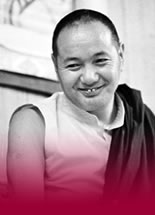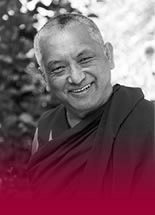Sherab Plaza: The Vision
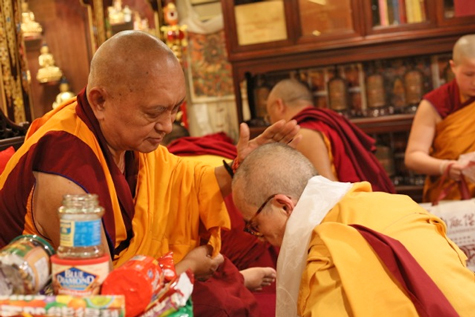
Sherab Plaza is a project of Ven. Robina’s to run commercial businesses and Dharma activities together in an urban six-acre complex, first in San Francisco and then in cities around the world.
“The idea is to use commerce to support various non-profit activities,” Ven. Robina says, relieving the plaza’s Dharma centers of the need to fund-raise. “Commerce works in the West – we love to spend money on ourselves! So why not use it for the greater good? It’s a perfect way to meld the systems that we have developed in our culture with the wish to provide freely all our services in keeping with the Buddhist tradition of giving.”
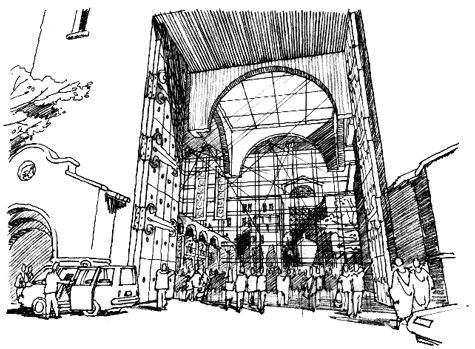
One of the design proposals for the entrance to Sherab Plaza. Design ideas by Eric Meub, Smith Group.
In addition to its Dharma centers and charitable projects, Sherab Plaza will include a monastery for 100 monks and nuns, giving them a home; a Buddhist university; an acre of gardens; and housing for the homeless (off site).
The plaza’s commercial activities will include the sale and timeshare of condominiums, an hotel, a car-parking business, a Buddhist book-café, a vegetarian restaurant, spa, gym, theater, conference center, shops and a daycare center.
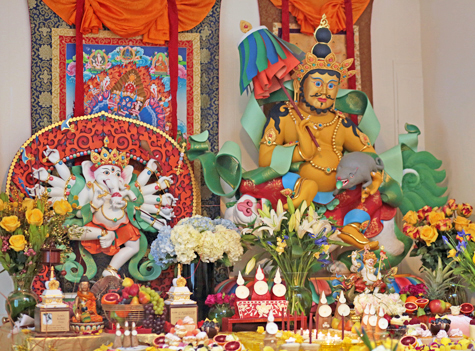
Three wealth deity statues instructed by Lama Zopa Rinpoche to be built for the success of Sherab Plaza: a three-foot Ganapati (left), five-foot Nam-tu-se (right) and one-foot Dzambhala (just below Nam-tu-se's left foot). The statues were made by Peter Griffin in the UK throughout 2007-2009; and consecrated in January 2013 at Land of Medicine Buddha in California.
In May 2006 Ven. Robina presented a 25-page Power Point of the project to her teacher Lama Zopa Rinpoche, the spiritual director of FPMT, in Perth. Rinpoche gave his full support: “Whether small success or big success, it will be achieved,” Rinpoche said.
Rinpoche advised various practices for the success of the project: the making of two sets of wealth vases; the making of three Guru Rinpoche statues; the making of three statues of wealth deities; and reciting a powerful prayer to Guru Rinpoche, or Padmasambhava, for removing obstacles.
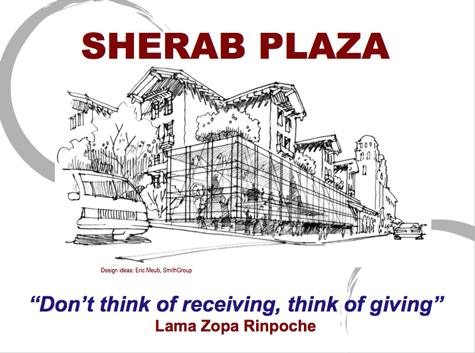
The first page of the PowerPoint presented to Lama Zopa Rinpoche in Perth in 2006. Design ideas by Eric Meub, Smith Group.
The idea of using commerce to support the Dharma work has long appealed to Ven. Robina. She was first inspired by Peter Kedge, Lama Yeshe's attendant in 1979, who went to Hong Kong to start a business to support FPMT.
In 2004, the work of Liberation Prison Project, the FPMT charitable project that Ven. Robina was then running, supporting men and women in prison around the world with their Buddhist practice, was growing fast – each month more and more letters were coming. Ven. Robina decided to move the project from Taos, New Mexico, where she was then based, to San Francisco, hoping a bigger city would provide more support and volunteers. She teamed up with the San Francisco FPMT center Tse Chen Ling, who offered office space at their center. Needing to bring in more funds each month as more and more prisoners started writing, and also seeing the struggles of Tse Chen Ling to bring in funds for their philanthropic work, the concept that would become "Sherab Plaza" began to grow in Ven. Robina's mind.
She mentioned the idea of a Dharma center supported by commercial activity to her friend Tove Beatty, who had come on to do LPP's accounts and be the operations person. Tove said, "Great, I’ve got these architect friends, why don’t we invite them for lunch?" And it grew from there.
Organically, through word-of-mouth, and friends of friends who heard about the project, a team of professionals came together: architects, real estate specialists, designers, Buddhists, non-Buddhists – all people working in the commercial world who were inspired by the idea of commerce supporting non-profit work. This team worked together for a couple of years in San Francisco, developing the groundwork for Sherab Plaza.
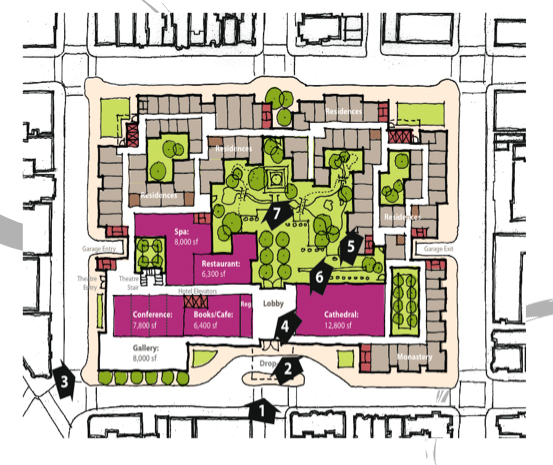
One of the initial architectural sketches for the layout of the plaza. Design ideas by Eric Meub, Smith Group.
The architectural firm Smith Group, one of the largest architecture, engineering and planning firms in the U.S., came on board, offerring $50,000 worth of pro-bono work. The Staubach Company, one of the leading providers of corporate real estate services, offered their services, introducing the Sherab Plaza team to Andrew Junius, a well-known zoning lawyer in San Francisco. Toma Barylak, one of the senior associates at Staubach, worked closley with Ven. Robina and together they came up with the name "Sherab Plaza": sherab means "wisdom" in Tibetan. Keisha Roberts came on as the first project manager in 2006. And a kind sponsor, Ven. Jangchup Phegey, offered $115,000, which paid for the building of the three wealth deity statues and also helped fund Keisha's salary.
"We started growing this plan, doing the practices Rinpoche recommended, creating the blueprints for Sherab Plaza," Ven. Robina says. "People were inspired by the idea and wanted to work with us."
And Liberation Prison Project and Tse Chen Ling worked together on various projects under the auspices of Sherab Plaza, putting on different events to raise money for their work, including the 2008 Happiness & Its Causes conference in San Francisco.
Most recently the three big statues of wealth deities were consecrated at Land of Medicine Buddha in California in January 2013. "A marvelous event. A nice next step." Ven. Robina says.
In 2006 it was estimated it would cost $700 million to fund the entire project. "Sure, it looks insane," says Ven. Robina. "But an idea costs nothing. And this is what people are doing every day, all the time. Our team all worked on such projects, so for them it wasn’t insane. They were the ones who inspired me to keep moving; they were honored to be part of such a project."
"I offer mandalas daily for Sherab Plaza's success, for it to manifest. Whether it’s this life or next life, it doesn’t really matter. I’d love to do Sherab Plazas all over the world. Have one in New York, one in Sydney, one in London. We’ve done the practices Rinpoche recommended, so who knows what will happen!”
Appreciation & Enthusiasm
“Sherab Plaza is an opportunity that comes along once in a lifetime if one is fortunate. To be involved in a project that contributes to a community spiritually, esthetically, and environmentally is rare. My hope: that Sherab Plaza opens the door for industry change and that Return on Investment will not be measured in dollars alone.”
– Nolen Boyer, The Staubach Company
“Sherab Plaza – and the motivation behind it – is a prescient introduction to a new mode of commerce that the world must embrace in the years ahead so that an increasingly scarce resource, land, is used wisely in order to create the most good for the most people. A large-scale and complex real estate development, it is also a shining example of what can be achieved socially, ecologically, architecturally, philanthropically and commercially, when we redefine the word ‘shareholder’ to include all of us, not just the select few in the boardroom."
– Toma Barylak, The Staubach Company
“One of Buddhism’s great beauties is its emphasis on gaining spiritual transcendence through immersion in the world. Sherab Plaza is a milestone project for SmithGroup: a global center for Mahayana Buddhism in the United States, an urban landmark within San Francisco, an enclave that holds places of action, rest, spiritual growth and enjoyment that will draw people of all religions and perspectives, and at the same time be as financially viable and profitable as any other major urban development. The ambition and vision of Sherab Plaza is breath-taking yet completely feasible.”
– Eric Meub, Smith Group
“I believe that significant Tibetan Buddhist monasteries with lay communities need to be created in the West to help assure the deepening and furtherance of the Dharma. The Sherab Plaza initiative represents the largest initiative to date and the first to build such an integrated community. We have the volition, know-how and resources to fully commit with Ven. Robina Courtin to see this dream into reality. Thank you for this opportunity to serve.”
– Anders Ferguson, Uplift Equity Partners
“The authentic Buddha Dharma lineage is increasingly transmitted and practiced in the West. The main impediment for Western Buddhists now seems the absence of a culture conducive to integrating Dharma practice with dominant Western culture. Sherab Plaza can contribute to the creation of such a culture.”
– Sander Tideman, Teleos Leadership Institute
